Dylan Klebold's Death
Did Dylan Klebold kill himself?
If so, how? If not, what happened?
An objective, thorough
“#903: Intra-tec 9mm model TEC-DC9, semiautomatic pistol, S/N D076305, one round in chamber, live rounds in magazine.” [Source: Library, Team 2, p.12325]
Why do people question Dylan Klebold's death?
Although Klebold’s death was ruled a suicide, some believe he didn’t commit suicide and instead, believe Harris killed Klebold. This claim was first published in the National Enquirer alongside two leaked photos of the shooters’ bodies.
Some say the evidence supports this conclusion, but that's false. Both the evidence and photos suggest Harris died first, which means he could not have killed Klebold.
First, let’s take a look at why people believe Harris killed Klebold.
Did Eric Harris kill Dylan Klebold?
Those who believe Harris killed Klebold generally hold the following misconceptions:
(1) The fatal shot entered through Klebold’s left temple. Klebold was left handed, but the TEC-DC9M was found under his right palm. Klebold could not have achieved the fatal bullet’s trajectory through his left temple using his right hand, and since the gun was found under his right hand, Harris planted the pistol to make Klebold’s death appear as suicide forgetting that he was left-handed.
(2) Klebold was found tightly gripping the TEC-DC9M in his right hand, and he couldn't have shot himself with his right hand so this either means Eric planted the TEC in Klebold's hand after he killed him, or Klebold was holding his TEC when Eric killed him.
(3) The TEC-DC9M was found without a magazine attached and a live round in the chamber. Since a magazine is needed to load a live round into the chamber, it's impossible for Klebold to have shot himself with no magazine in the gun and still end up with a live round in the chamber.
(4) Harris likely killed Klebold with the Hi-Point rifle--not the TEC-DC9M.
ALL of these claims are demonstrably false.
Here is the evidence-based truth:
1. The fatal trajectory would have been easy for Klebold to achieve via suicide and the fact that the TEC was found under his right hand has no bearing on what hand pulled the trigger because (1) the gun was upside down under his palm, which means if someone 'planted' the gun under his hand, they planted it upside-down, which makes no sense. And (2) the gun was attached to a strap around his body and would have fallen from his grip, remaining close to his body no matter how he (or anyone else) pulled the trigger;
2. Klebold was not found “tightly gripping” the TEC-DC9M. His fingers were "slightly curved" over the grip (backwards - with his pinky finger close to the trigger box);
3. The TEC-DC9M was found with a loaded magazine attached; and
4. The TEC-DC9M unquestionably fired the fatal shot (not the carbine). There was drawback in the barrel of the TEC matching Klebold's DNA, which means the fatal shot came from the TEC. The fatal bullet came from Firearm Discharge #11.
Now let’s look at each claim in-depth.
Point #1: The angle of Klebold's wound
Myth: The angle of Klebold's wound is impossible to achieve via suicide
Evidence-based truth: The angle would have been possible to achieve via suicide, but only in certain ways.
COULD KLEBOLD HAVE ACHIEVED THE DOCUMENTED TRAJECTORY VIA SELF-INFLICTION?
Short answer: Yes, it would have been possible by gripping the pistol with two hands.
Klebold’s wound was found ‘consistent with suicide’
This is the approximate trajectory of the bullet that killed Klebold. Since we don’t have autopsy diagrams, it’s hard to determine the exact points of entry and exit.

Dr. Ben Galloway, the coroner who examined Klebold’s body, described the wound:
“The projectile penetrated the cranium through the left temporal bone; extended across the undersurface of both cerebral hemispheres; exiting the head through the right temporal bone…
The projectile traveled left to right slightly front to back and slightly downward. The characteristics of the wound are consistent with a large calibre weapon; with a close contact range of fire; consistent with self-infliction.”
-Klebold’s autopsy report
Klebold's wound was found to be "consistent with suicide," but there's something contradictory about what Dr. Galloway described in the autopsy report. He wrote, "The projectile traveled left to right slightly front to back and slightly downward. The characteristics of the wound are consistent with... self-infliction.” According to decades of research, a downward bullet path is indicative of homicide, not suicide.
From a study published in 2002 titled Autopsy features relevant for discrimination between suicidal and homicidal gunshot injuries:
"Consequently, some bullet path directions cannot be considered indicative of suicide: downwards and back-to-front in gunshots to the temple, left-to-right in gunshots to the left chest and downwards in mouth shots. The isolated autopsy findings can only be indicative of suicide or homicide but the combined analysis of several findings can be associated with a high probability."
It's also uncommon for suicides to have no barrel contact, although it does happen. It's just rare. Given the weight and size of Klebold's pistol combined with the angle that would have bent his wrists unnaturally inward, it's hard to believe he shot himself with one hand pulling the trigger.
Klebold has two unusual wound characteristics for a suicide: no contact and a downward bullet path.
Although these points should be taken into account - a downward bullet path by itself, and a lack of barrel contact - it doesn't mean Klebold was killed. It's possible that he engaged in a rushed, sloppy suicide where he grabbed the pistol with two hands, didn't press the barrel to his head, and pulled the trigger quickly as he moved the gun to his temple.
Could Klebold have achieved this angle via suicide?
While he couldn’t have achieved the documented trajectory by pulling the trigger with his right hand only, it would have been easy and natural for him to achieve the documented trajectory via self-infliction while holding the gun with both hands.
Possibilities: (1) He could have held the grip with both hands, right hand on the bottom, pulling the trigger with his left thumb… or (2) He could have held the magazine in his right hand, the grip in his left hand, pulling the trigger with his left thumb.
If holding the magazine sounds like an awkward way to commit suicide, rest assured, it’s not. It’s actually the most natural way to turn a TEC-9 on yourself.
Why would Klebold hold the magazine (if he did?)
The TEC-DC9M magazine is forward of the grip, making the pistol unbalanced and front-heavy. In the absence of a mounted forward pistol grip, which is illegal, people commonly fire TEC-9 models by holding the magazine in their non-dominant hand.
It would have been natural for Klebold to hold the magazine in his right hand with his left hand on the grip. From there, it would have been a simple, natural movement to turn the gun on himself and fire the fatal shot pulling the trigger with his left hand while still holding the magazine in his right hand to steady the shot. From there, the gun would have fallen, but since it was on a strap, it would have stayed close to his body as he fell. Since his right palm was resting over the gun backwards, there is no reason to believe he 'gripped the gun' as he died, so this scenario makes sense.
You'll see the simplicity of this movement below.
It’s natural to hold the magazine when firing a TEC-9
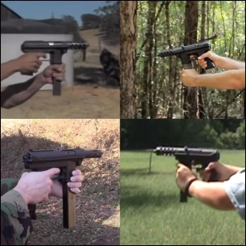
If Klebold held his pistol this way, it would have been natural and easy to turn the gun to his left temple at the documented angle and pull the trigger while achieving the documented angle. Plus, holding the magazine would have countered the downward pull from the loaded magazine's weight.
Put video here showing the movement.
The fact that Klebold’s right fingers were found slightly curved over the grip indicates he was gripping that part of the pistol when he died. However, remember that this was an upside-down grip. The most logical answer is that the gun fell underneath his body as he fell to the floor and he grabbed for the gun as he died.
Point #2: Klebold's TEC was found with the magazine well pointing toward his left leg
Myth: The TEC-DC9M was found under Klebold's leg with the open end of the magazine well facing away from his right leg.
Evidence-based truth: The TEC-DC9M was found under Klebold's leg with the open end of the magazine well facing between his legs, toward his left leg.
 |
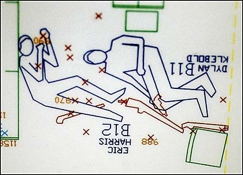 |
|---|
Most people assume the TEC-DC9M was found underneath Klebold's leg with the magazine well pointing out from his right leg, away from his body. However, it was actually found in the opposite orientation. The magazine was pointing toward his left leg.
Point #3: The TEC-DC9M was found with a magazine attached
Myth: Klebold's TEC-DC9M was found without a magazine attached and one round in the chamber. If a magazine was attached to the TEC when found, surely it would be visible in the leaked photos, but there is no magazine visible.
Evidence-based truth: Klebold's TEC-DC9M was found with a loaded magazine attached and one round in the chamber. The reason no magazine is visible is because there is no magazine (and no pistol) in the leaked photos. This will be discussed in the next point (#4).
Page 12325 from the Library Teams 1-7, Team Two report describes the condition of each weapon as it was found.
The TEC-DC9M is described as being found with “one round in chamber, live rounds in magazine.”

The original handwritten notes documenting the condition of the firearms found, including whether the safety was on or off, can be found in the CBI documents.

The TEC-DC9M was originally documented as “loaded mag 1 in chamber safety? NO.” (Source: CBI; Crime Scene Report Team Two, p.347)
Why does it matter if there was a magazine in the TEC-DC9M?
A live round in the chamber of the TEC-DC9M indicates the last shot was fired while a magazine was attached. After each shot from a semi-automatic pistol, a round is loaded into the chamber, fed from the magazine. A pistol won’t load a new round in the chamber without a magazine attached. No magazine would mean either (a) someone removed the magazine after the fatal shot was fired or (b) the fatal shot wasn’t fired from the TEC-DC9M.
If Klebold shot himself with the TEC-DC9M without a magazine inserted, he would have fired the last remaining bullet from the chamber and the chamber would be empty.
However, all of these points are irrelevant since the TEC-DC9M was, in fact, found with a loaded magazine.
Three troublesome conclusions are drawn from the false belief that the TEC-DC9M was found without a magazine:
(1) Klebold couldn’t have killed himself with a pistol that didn’t have a magazine attached and feed a live round into the chamber. (true, but the pistol was found with a loaded magazine so this conclusion is invalid)
(2) The only other person in the room was Harris, therefore Harris killed Klebold. (this is an assumption and is demonstrably false)
(3) Without a magazine attached, the TEC-DC9M could not have been the weapon that fired the fatal shot. Unless the person who fired the fatal shot removed the magazine afterward and placed the pistol in Klebold’s hand. (true, but the TEC-DC9M was found with a magazine attached and was the gun that fired the fatal shot, which makes this conclusion invalid)
Some people argue that when the TEC-DC9M was described as being found with “one round in chamber, live rounds in magazine,” that doesn’t mean the magazine was inserted into the weapon. However, that’s exactly what it means.
Investigators do not document the condition of a weapon when found by including a description of a magazine found on the floor near the firearm. Only an inserted magazine would be described as part of the firearm’s condition when found.
The documented condition of the TEC-DC9M proves the magazine was inserted into the TEC-DC9M when recovered by investigators.
If you’re still not convinced the magazine was inserted into the TEC, consider that Harris’ rifle was documented as ‘empty,’ yet a rifle magazine was located right next to the firearm. The rifle’s magazine was not documented as part of the rifle’s condition. Only an inserted magazine would be documented as part of a firearm’s condition when found.
 |
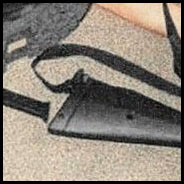 |
|---|
Isn't there a CBI document that documented the TEC-DC9M as being received without a magazine?
This document exists, but has nothing to do with the crime scene. This is a lab receipt, although some people falsely use it to support their stance that the pistol was found without a magazine.
The document in question is a lab receipt record of the CBI receiving the TEC-DC9M as evidence on May 4, 1999 so it could be test fired. The pistol was documented as it arrived to the CBI lab without a magazine.
It should be noted that the CBI officially requires all firearms to be unloaded before shipping or transporting to their facility. Chambers must be empty and magazines must be detached before being transported even in a vehicle.
Point #4: There is no TEC-DC9M in the leaked photos
Myth: The "suicide photos" leaked to the National Enquirer show the TEC-DC9M under Klebold's leg and right hand.
Evidence-based truth: There is no TEC-DC9M in the leaked photos; it was removed from the scene hours earlier.
This misperception is an optical illusion created by the leaked photos that imply the gun is under Klebold's right hand in the photo. In fact, there is no TEC-DC9M in the leaked photos. It has already been removed from the scene. Only the strap is under Klebold's hand.
When Klebold's body was found, both the TEC and his hand were concealed under his leg. In the leaked photo, the TEC's strap has been visibly cut and the pistol has been removed, which is why his right hand is now completely visible. When found, his hand was concealed underneath his leg.

The TEC was removed at 3:35 p.m. on April 21
Triena Harper (Chief Deputy Coroner), Alan Hammond (Denver CBI), and Tom Griffin (Denver CBI) removed the TEC-DC9M from Klebold’s hand at 3:35pm on April 21 (p.12302).
The leaked photos are from roll #8, which was taken just before 7:00 p.m., hours after the TEC had been removed from the scene. You can see the cut strap in the scene, and that cut was not there prior.
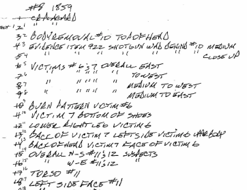
Overall photos were taken of the bodies on roll #8. There is no other description of overall photos for bodies 11&12 (Harris & Klebold). (Source: CBI, p.787 of 858)
Why is the strap in Klebold's hand?
The TEC-DC9M has a single sling point mount for the strap on the back of the pistol. When investigators removed the pistol from underneath Klebold's right hand, there would be a section of strap next to his hand. It makes sense that after removing the pistol, his hand would then naturally come to rest on top of the strap.
Point #4: Klebold was not found "tightly gripping" the pistol
Myth: Klebold was found "tightly gripping" the TEC-DC9M.
Evidence-based truth: JCSO detective Jim Jennings documented Klebold’s fingers as being “slightly curved” with his palm down.

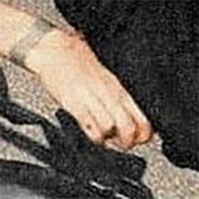
Does this look like a tight grip? Klebold's index and middle fingers are loosely curved and his middle finger is so loosely curved that you can see the inside of his finger. You could probably stick a toothbrush through his pointer and middle fingers they’re so loose. This is not a tight grip.
Why does it matter if Klebold’s hand was tightly gripping the pistol?
When you think he was found “tightly gripping” the pistol, the next question is, “why would he be gripping the pistol with his right hand when it would have been impossible for him to shoot himself with his right hand? Eric must have killed him!” This conclusion is based on a faulty premise.
Other than this handwritten note, there are only three places where the gun is described being in Dylan’s hand, none of which say he is 'gripping' or 'tightly gripping' the gun:
(1) States the gun was “in the right hand and under the right leg of Klebold” [Source: Library, Team 2, p.12302]
(2) States the gun was “removed from Klebold’s right hand” [Source: Library, Team 2, p.12302]
(3) States his “right hand was around the grip of the Tec-9 pistol” [Source: Library, Team 2, p.12303]
Again, that Klebold's hand was over the pistol is meaningless because (1) it was upside-down under his palm with his pinky finger near the trigger, and (2) the gun was on a strap, so of course it would stay close to the right side of his body as he fell on his right side.
Point #5: The TEC-DC9M was found with a magazine attached
Myth: Klebold's TEC-DC9M was found without a magazine attached and one round in the chamber. If a magazine was attached to the TEC when found, surely it would be visible in the leaked photos, but there is no magazine visible.
Evidence-based truth: Klebold's TEC-DC9M was found with a loaded magazine attached and one round in the chamber. The reason no magazine is visible is because there is no magazine (and no pistol) in the leaked photos. This will be discussed in the next point.
Page 12325 from the Library Teams 1-7, Team Two report describes the condition of each weapon as it was found.
The TEC-DC9M is described as being found with “one round in chamber, live rounds in magazine.”

The original handwritten notes documenting the condition of the firearms found, including whether the safety was on or off, can be found in the CBI documents.

The TEC-DC9M was originally documented as “loaded mag 1 in chamber safety? NO.” (Source: CBI; Crime Scene Report Team Two, p.347)
Why does it matter if there was a magazine in the TEC-DC9M?
A live round in the chamber of the TEC-DC9M indicates the last shot was fired while a magazine was attached. After each shot from a semi-automatic pistol, a round is loaded into the chamber, fed from the magazine. A pistol won’t load a new round in the chamber without a magazine attached. No magazine would mean either (a) someone removed the magazine after the fatal shot was fired or (b) the fatal shot wasn’t fired from the TEC-DC9M.
If Klebold shot himself with the TEC-DC9M without a magazine inserted, he would have fired the last remaining bullet from the chamber and the chamber would be empty.
However, all of these points are irrelevant since the TEC-DC9M was, in fact, found with a loaded magazine.
Three troublesome conclusions are drawn from the false belief that the TEC-DC9M was found without a magazine:
(1) Klebold couldn’t have killed himself with a pistol that didn’t have a magazine attached and feed a live round into the chamber. (true, but the pistol was found with a loaded magazine so this conclusion is invalid)
(2) The only other person in the room was Harris, therefore Harris killed Klebold. (this is an assumption and is demonstrably false)
(3) Without a magazine attached, the TEC-DC9M could not have been the weapon that fired the fatal shot. Unless the person who fired the fatal shot removed the magazine afterward and placed the pistol in Klebold’s hand. (true, but the TEC-DC9M was found with a magazine attached and was the gun that fired the fatal shot, which makes this conclusion invalid)
Some people argue that when the TEC-DC9M was described as being found with “one round in chamber, live rounds in magazine,” that doesn’t mean the magazine was inserted into the weapon. However, that’s exactly what it means.
Investigators do not document the condition of a weapon when found by including a description of a magazine found on the floor near the firearm. Only an inserted magazine would be described as part of the firearm’s condition when found.
The documented condition of the TEC-DC9M proves the magazine was inserted into the TEC-DC9M when recovered by investigators.
If you’re still not convinced the magazine was inserted into the TEC, consider that Harris’ rifle was documented as ‘empty,’ yet a rifle magazine was located right next to the firearm. The rifle’s magazine was not documented as part of the rifle’s condition. Only an inserted magazine would be documented as part of a firearm’s condition when found.
 |
 |
|---|
Isn't there a CBI document that documented the TEC-DC9M as being received without a magazine?
This document exists, but has nothing to do with the crime scene. This is a lab receipt, although some people falsely use it to support their stance that the pistol was found without a magazine.
The document in question is a lab receipt record of the CBI receiving the TEC-DC9M as evidence on May 4, 1999 so it could be test fired. The pistol was documented as it arrived to the CBI lab without a magazine.
It should be noted that the CBI officially requires all firearms to be unloaded before shipping or transporting to their facility. Chambers must be empty and magazines must be detached before being transported even in a vehicle.
Point #6: Why doesn't the crime scene sketch show a magazine?
Myth: The sketch artist didn't draw a magazine in the TEC, therefore it must have been found without a magazine, regardless of the documentation.
Evidence-based truth: There are plenty of things that don't get drawn in a sketch. The documentation of the weapon's condition when found says the magazine was in the gun.
As an example of how not all details are drawn, the crime scene diagram depicts the following:
- Harris’ shotgun is too low and at the wrong angle
- The Hi-Point carbine rifle is drawn with the magazine well in the middle of the stock area
- There is no trigger depicted on Harris' shotgun, but we know it had a trigger
- Klebold’s shotgun is depicted as a bumpy rectangle with a closed action, but it was found with the action open
The diagrams are not meant to be detailed, perfectly accurate depictions of the scene. They don’t accurately depict any of the weapons in detail because they use shapes that represent general firearms.
The fact that the sketch artist didn’t draw a magazine in the TEC-DC9M is a reflection of the simplicity of the sketches, not the absence of documented evidence. And it's not just the TEC-DC9M that lacks detail in the sketches. All the firearms lack details. They’re simply shapes that represent the firearms.
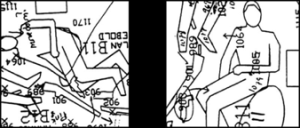

Point #7: The TEC-DC9M fired the fatal shot
Myth: Harris killed Klebold with the Hi-Point rifle.
Evidence-based truth: The TEC-DC9M unquestionably fired the fatal shot.
One to one-and-a-half inches of drawback matching Klebold’s DNA was found inside the barrel of the TEC-DC9M. This means the TEC-DC9M fired the fatal shot.
Some have dismissed the presence of drawback by saying there were merely meaningless “traces of blood” matching Dylan’s DNA inside the barrel of the TEC-DC9M. The implication is that “traces of Dylan’s blood” could have gotten into the barrel accidentally.
This is incorrect.
Drawback is not the same as “traces of blood.” “Trace evidence” refers to small, minute, often microscopic amounts of evidence. There is nothing minute or microscopic about 1-1.5” of blood in the barrel of the TEC-DC9M. Drawback is not just random blood that manages to flow into a muzzle from a puddle of blood or any other source. It comes from the impact of the bullet when the blood travels backwards into the barrel along the bullet's path. The only way drawback matching Klebold’s DNA got into the TEC-DC9M is if the fatal shot was fired from the TEC-DC9M.
"There was a flow pattern extending inside the barrel muzzle about 1 to ½ inches.” (Source: Evidence Volume 2; CBI Reports, p.12112)
“There was a flow pattern extending inside the barrel muzzle about 1 to ½ inches.” [Source: CBI, Trace Arson page 3 of 77]
“The DNA profiles developed from items #23A and 23C (Tec 9 pistol) matched the DNA profile from Klebold.” [Source: CBI, DNA Reports, p.53]

The 9mm shell from the bullet that killed Klebold (JCSO #8680/CBI #261) was recovered, no DNA was found and it wasn’t traced to a specific gun. [Sources: CBI, Team 2, p.370; Evidence Vol. II p.12206; Library Team 2, pp.12316-12317]
Point #8: Klebold's body was not moved to look for bombs
Myth: In the leaked crime scene photos, Klebold is on his back because they moved him during the bomb sweep.
Evidence-based truth: The bomb technicians were specifically instructed not to move the shooters' bodies while searching for and collecting bombs. At least two bomb sweeps were done before their bodies were moved to retrieve the remainder of IEDs from their inaccessible pockets.
“The sweep was done to determine if there were any additional live IEDs (with the exception of any more that would be found on the bodies of KLEBOLD and HARRIS, which had not been moved at this time). [Source: 11k, p.7811]
Point #9: Eric Harris died first
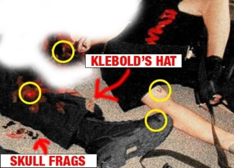
We know Harris died first because there is impact splatter on his left leg/knee area from Klebold’s exit wound. Klebold's wound and the middle of the impact splatter on Harris' leg would align perfectly if you rolled Dylan back over onto Eric’s left leg.
Klebold’s skull fragments landed between Harris’ legs while his hat was blown off his head, landing against the outside of Harris’ left leg. This is in alignment with the bullet's path.
There are also points of blood transfer on Dylan’s body and Eric’s body that would align perfectly if you rolled Dylan back over onto Eric’s left leg.
Klebold fell forward with the right side of his head briefly resting on Harris’ leg before rolling onto his back where he aspirated blood.
“Some of the blood flows on the face were also formed with the head in a position other than as found. These flows were consistent with KLEBOLD’S head resting on the right side of the face to allow the blood flow on the left side out of the wound.” [Source: Library Team 2, p.012321]
How do we know Klebold fell onto Harris’ leg and not somewhere else? The impact splatter is visible on Harris’ leg along with the additional blood that flowed out of his wound. The blood on Harris' pants came from a flowing source, and that source was Klebold's wound.
Ideally, we’d have the DNA test results from Eric’s pants to know for certain, but we don’t have that information.
Some people believe it’s merely an assumption that the blood on Eric’s leg came from Dylan, but here's how we know, even without DNA test results:
1. Impact spatter from a gunshot wound is created when blood/brain matter impacts an object while traveling in the same direction as the bullet.
2. Klebold’s brain matter is between Harris’ legs. Klebold’s brain matter would only be between Eric’s legs if his exit wound was at a slight angle or perpendicular to the floor. A shot fired into Klebold’s left temple at that angle that blew his brain matter between Harris’ legs would also create impact spatter in the same area as Harris’ left leg.
The final fact that supports the blood on Harris’ left leg being from Klebold’s exit wound is that we know blood flowed out of Klebold’s exit wound while he was resting on the right side of his face. If you rolled Klebold’s body toward Harris, his right temple would be on Harris’ knee.
Since Klebold’s brain matter was found between Harris’ legs, we know Klebold’s exit wound was above Harris’ leg when the bullet went through his head.
If Harris shot Klebold, Klebold’s blood would have been found underneath Harris’ leg because that’s where he would have landed on the right side of his face.
All of Klebold’s blood, spatter, splatter, brain matter, etc. was found in a pattern on either side of Harris’ leg. Not under Harris' body. This pattern would only exist if the blood on Harris’ pants is Klebold’s.
3. The void. There is a void around the area where Klebold’s exit wound came from. A void is not the absence of evidence, I need to make this really clear. A void is a bloodstain pattern that includes an area where blood should be, but isn’t, because something was in the way when the impact occurred.
The blood on Harris' pants is not back spatter from a victim for several reasons. Back spatter is more of a mist and small particles. The blood on Harris' pants came from a flowing source, evidenced by the fact that it has flowed down all of the folds in his pants. Also, back spatter wouldn’t have a concentrated, circular pattern of darker blood in the middle.
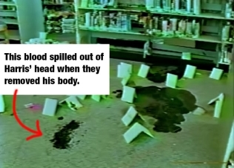
The only place blood flowed out of Klebold’s right temple was onto Harris’ left leg. If Klebold landed on the floor prior to Harris’ death, we would see an additional bloodstain on the carpet from when he rested on the right side of his face to allow blood to flow out of his wound.
The only bloodstains on the carpet are from Harris’ suicide by the bookshelf and below that from Klebold’s final position on his back.
The bloodstain on the carpet where Klebold’s right leg was, noted in the photo (left) spilled out of Harris’ skull when they moved his body.
Point #: Wasn't Harris' DNA found on the trigger are of the TEC?
Acknowledge Eric’s DNA found in the trigger area of the TEC.
We know he broke his nose, so there’s nothing strange about the possibility of his blood being found on the TEC.
We also see Eric shooting the TEC at Rampart Range, and he shot a pistol left-handed. We tend to assume they never interchanged weapons, but maybe they did. Or, Dylan touched something that had the transfer from Eric’s blood. The tendency is to assume this means Eric pulled the trigger, but the evidence doesn’t support Eric dying second.



